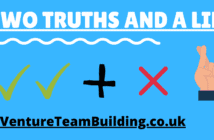
Team building retreats can be an incredibly powerful way to increase your workforce’s camaraderie, develop more productive relationships and improve levels of communication and cooperation. However, to ensure your team building retreat is effective, it’s essential to plan it carefully – otherwise it can quickly turn into an unproductive offsite meeting. And we all know how much fun unwanted meetings are…
In this guide, we’ll explain exactly why and how to plan a successful team building retreat for your business. You will learn:
- Why you should plan a team building retreat
- How to plan and prepare a successful retreat or outing
- How to choose a venue
- The types of activities that work best for retreats
What Is A Team Building Retreat?
A team building retreat is essentially where your business organises an out of office gathering of your company’s employees. Quite often they’re hosted in rural locations, providing an environment where your team can learn to really work together through a whole host of activities.
Most of the retreat’s tasks are aimed at strengthening coworker relationships, developing levels of communication and allowing you to monitor how your team works together in some challenging but fun situations.
Why You Should Plan A Team Building Retreat
Employees are the foundation of any successful business. It’s therefore essential that your team is working effectively together. A team building retreat has a diverse range of benefits, all of which can be powerful methods of enhancing your businesses’ success and bringing your teams together:
- Improve your team’s weaknesses and build on their strengths – no matter how strong your team is, there are always certain elements you can improve. With a team building retreat you can specifically target areas for improvement, with a clear purpose, educational goals and specifically choosing certain team building activities that will develop these goals.
- Be proactive – you might be able to see potential upcoming challenges within the team, in terms of relationships or communication. A team building retreat gives you the opportunity to shut the laptops and phones down and be completely proactive about the issues you’d like to work out.
- Bring your remote team together – even if you have a team that’s working remotely, team building retreats can still be very effective. In fact, it’s the perfect opportunity to bring your long distance team together and help them bond as a team. When most of your team haven’t met each other before, they can feel a little disconnected – an annual or quarterly event helps to address this issue.
- Motivation and job satisfaction – did you know that 64% of employees say that creating trust between staff and senior management influences job satisfaction? A retreat is the perfect opportunity to develop that bond between colleagues, whilst allowing time out of the office for your teams to become familiar with each other.
- Investing in your team – most employees don’t actually believe their organisations are working together as effectively as they could be. That’s generally because most businesses aren’t investing in the right type of training and resources that will develop their teams. Organising retreats allows your business to really focus on valuable team building exercises.
How To Plan A Successful Retreat Or Outing
Creating a successful team building event requires careful planning and each stage of the process has a purpose. Here are some clear steps on how to plan and prepare a successful team building retreat…
Planning committee – First of all, assign a team to plan the event. With your planning committee, make sure there’s a crossover between the team planning the retreat and those that are participating. If the delegates attending the event feel like they’ve influenced decisions in terms of the activities to be involved in, they’re more likely to be engaged on the day of the event.
Be clear about the purpose of your event – One of the biggest reasons why team building retreats are not quite as effective as they could be is the fact that there’s no set agenda or goals for the outcome of the event. Think about what would you like to achieve with the team building retreat and be very clear when communicating this to your team. Think about the reasons why you’re bringing the team together – this could include the following:
- To increase creativity and innovation
- Work on and develop a particular deficiency within the team
- Improve coworker relationships
- Enhance communication within the team
Set educational goals – After defining the purpose of your retreat, you may want to drill down further into educational goals. Be as specific as possible, as the more detailed your goal, the easier it is to measure success.
Increasing team engagement – to ensure your team building retreat is successful, it’s important to gain support and participation from the top executives in your business. They’re highly influential and leading by example creates a stronger motivation for other employees to engage in the retreat.
A retreat where only the relatively junior colleagues participate will not feel as important and therefore the attendees may not take it as seriously. Having a couple of leadership level employees within the group and participating like any other member creates a stronger sense of importance.
Choosing A Venue
With team building retreats becoming so popular, you have a vast range of options when it comes to choosing a venue. However, there are certain ways to optimise the event to ensure it’s as successful as possible.
This includes identifying the following:
- Does the venue specifically cater for team building retreats? Ideally, you should hire a venue that’s specifically designed and experienced in hosting team building retreats. They’ll therefore be able to assist you with organising the event, advising what activities and tasks are best suited to your company’s specific requirements.
- Where is the location based? Quite often locations in remote, quiet surroundings are best. They offer the ability for your employees to focus and concentrate on the team building activities. However, if you’re not supplying transport for the team then ensure it’s in a location that’s reasonable to travel to, depending on where your staff live.
- What facilities does the venue offer? Do they offer suitable accommodation? Are there places to eat and drink? What standard of accommodation should your business book for out of office events? These are some of the key venue questions that you should analyse when searching for a location to host the retreat.
- What is your budget? Obviously some venues are more affordable than others and if you’re a small business, it’s important to be realistic with your budget. However, depending on the size of your team you might be able to negotiate with the venue for a more reasonable rate.
- What activities do you want to include? As a core element of your retreat, you should find a venue that has a wide and relevant selection of activities suitable for your business. We discuss activities in the following section but as a general rule, each task should be fun, engaging and in line with your educational objectives for the retreat.
If you’re looking for a venue specifically in the US, here are some the top leadership and team building venues rated in order of preference. If you have close contacts from other organisations, they may also have recommendations for potential venues.
Types Of Activities That Work Well At Retreats
When it comes to choosing activities for the event, there are hundreds to pick from. From ‘egg tossers’ to ‘scavenger hunts’, there are some great icebreakers and team building activities for you to select. We recommend choosing activities that are relevant to the goals you have set (ie. Improved teamwork, strengthening communication between teams, etc), as these allow you to watch your team’s behaviour and see how they perform.
Some of the top team building activities include:
Ice breakers – ice breakers are a powerful way to remove the barriers that a formal business environment often creates. They work really well during the early stages of the retreat, to help people feel more relaxed and comfortable, whilst ensuring they’re engaged with the event. A few of our personal favourites are:
- Desert island – prepare your team by telling them that they’ll be flown off to a desert island and they’re only allowed to pack three items with them. Each delegate will then present their three items to the rest of the group, along with reasoning as to why they chose each one. Not only does this help your team members start to think pragmatically but it also offers a way to see their personality, how they think, and how they react to being ‘put on the spot’.
- Questions and answers – this is quite a fun concept, where team’s are provided with an answer and have to come up with as many relevant questions as possible. It’s a really useful way to warm your employees up for the retreat, as they have to start thinking creatively to solve the task.
- Getting positive – with your retreat delegates arranged in a circle so that they’re easily able to communicate to each other, ask your team members to be open and share their current worries, concerns or thoughts. You can then support each delegate that’s sharing their concerns by offering helpful questions to address each distraction. This ice breaker really helps to address any apprehensions your team may be feeling about the retreat or just in general, whilst creating a level of trust and mutual respect between each team member.
Games – games are great for team building, as you can organise activities that really bring people together with camaraderie. Try to organise games that are involving, require teamwork and most likely haven’t been played by anyone in the group. Some top team building games include the following:
- Foil fun – with two sheets of foil, teams have to sculpt the tinfoil into a shape or object that you specify. This is a creative task that’s perfect for the kinaesthetic learners in your team who are engaged by practical activities
- Bridge build – if your goals are to develop your team’s problem solving, communication and creative thinking skills, the bridge build task ticks all the boxes. Splitting your delegates into two groups, both teams have to work together to build half a bridge on either side, without being able to see each other. It’s also quite entertaining to watch!
- Big races – big races is a really fun game, involving wacky clothes, dressing up and plenty of hopping!
When selecting your choice of activities for your retreat, this resource might be useful as it has a list of over 60 free team building activities. There’s a game to suit every organisation’s team building needs on this list!
Struggling For Team Engagement?
With any business event, formal or informal, people tend to worry that it’s going to be a dry and slightly dull affair. That’s why you should try to innovate with your team outing, avoiding the monotony of most generic retreats. Make the effort to stand out as an employer who truly cares about building a team. Not only does this make your retreat more enjoyable, it helps build the culture of an innovative and forward thinking business.
With the below tips, ensure you have the foundations of your business retreat organised first – such as your goals, agenda, activities and schedule for the day. Then once you have the basics covered, think about how you can create a unique, unforgettable and truly rewarding retreat for your employees and your company. Here are some creative suggestions:
- Novelty – serve food that people love and brings interest to the table (no pun intended!) – for example, it could be exotic international cuisine or vegan food. You could even host a cooking class as part of your event, where people can work together as a team to cook a great dish!
- Guest instructors – hiring a guest instructor is a great way to test your team’s ability to learn new things, whilst it’s also new and exciting. Whether it’s a teacher specialising in kayaking, tug of war or doubles table tennis, introducing a new person really helps to engage your team members.
- Hire a motivational speaker – hiring a passionate motivational speaker is a great way to engage and inspire your employees, whilst acting as a welcome break from the activities and group tasks that can become a little intense. Motivational speeches can add a burst of energy to a retreat and you could even theme your motivational speech around the importance of teamwork, collaboration and working together. If you’re short on time, this doesn’t need to be a long session – between 15-30 minutes is enough to create an impactful message.
- Record videos and pictures from the retreat – this makes the event more memorable and it’s great for sharing via social media or on your company’s internal network. This could include a video interview after the retreat with your team, action clips from the activities or just a few high quality pictures that highlight the fun side of your company’s culture.
What You Should Avoid (And When NOT To Organise A Company Retreat)
A business retreat isn’t suitable for every organisation. Sometimes they’re simply not relevant to your objectives as a business.
Here are some common scenarios where a team building event isn’t relevant and some alternative solutions:
- Tight deadlines – if you’re running a seasonal business where clients are demanding and deadlines are likely to be tight, a team building retreat could be a little distracting. In this situation, it’s simply a case of working around the timing. Try to organise the retreat after peak season, as then you can afford to be more proactive with team building. The retreat could even be positioned as a reward for your team performing so well, highlighting the fact that you appreciate their hard work.
- Very small teams – if you run a very small business, with just 2 or 3 people in the company, a team building event isn’t really relevant. However, as an alternative you could organise a mini social event that requires less organisation such as a team meal, bowling or informal drinks. For more adventurous teams, you could arrange an exciting outdoor activity like skydiving or white water rafting.
- Limited financial resources – when budgets are limited and you’re struggling to keep afloat as a business, a team building retreat might be a relatively expensive luxury that your organisation can’t afford. You could delay the retreat and wait for your company’s financial performance to improve. Another option is to consider less expensive team building events, such as an onsite team building day, which can still be fun and effective. If this applies to your company, you might check out this list of 60 free team building activities
There are some common pitfalls that many organisations repeatedly fall into the habit of. Whilst some of the below mistakes might seem intuitive, we recommend avoiding them as they can really hinder the progress of your team building efforts:
Poor organisation – try to stick to a fairly organised time schedule and create an agenda for the day. It’s easy to stray off on a tangent with a team building retreat, which leads to you failing to achieve your retreat’s goals. Assign a dedicated facilitator for the day who’s in charge of managing the retreat.
Lack of engagement – people naturally tend to get bored and distracted if a retreat isn’t engaging enough. Make sure your activities are fun and challenging, and take regular food and beverage breaks to refresh your team’s concentration levels. If you have members who are shy or slightly introverted, try to encourage them to be involved in the group activities so that they feel more comfortable and relaxed.
Invite everyone – a team building retreat should bring everyone relevant together. Failing to invite certain people in the organisation could have a negative impact on employee morale, which is the opposite of what you’re trying to achieve. Ensure it’s an inclusive event that brings your workforce together, rather than shutting particular employees out.
Failing to set goals – if you don’t set goals for the retreat, it’s going to be difficult to measure the event’s success. When financial resources are invested into the event, you should be able to prove the return on investment, even if this is a qualitative result. Goals are the foundation of any team building event, helping you to understand what activities you should select, how to organise the day and which specific skills you would like your team to develop.
Calling it a retreat – yes, this guide does commonly refer to an off site team building event as a business retreat! However, the word ‘retreat’ might have some negative connotations and imply that you’re ‘escaping’ work. Seth Godin actually recommends calling the event an ‘advance’ for this reason. Whatever you decide to call your event, make it sound fun and appealing to the people you invite.
Asking for feedback – so many organisations fail to ask for feedback after holding their retreat. This is a great opportunity to find out how you can improve your next session, if you ask the right questions. Ask for feedback after the final activity before everyone leaves. That way, the experience will still be fresh in your attendee’s minds and they’ll be able to provide clearer suggestions. Preferably collect feedback right away (avoid collecting the forms at a later date) via an individual rather than a group contribution, as your delegates can be honest and won’t have to worry what their colleagues think about their ideas.
Conclusion: Plan For Success
As you can see from the above guide, planning a team building retreat is a great team building technique that’s fun and more importantly, effective. From improving your team’s weaknesses to increasing levels of communication, there’s a whole host of powerful benefits that are useful for any team. Whilst it’s important to be aware of common retreat planning mistakes, such as poor planning or not engaging your employees, with the above tips you should understand exactly how to overcome these challenges.
If you’re planning a retreat, check out our Team Building Activity book. It’s available for instant PDF download, and is filled with 30 of our best activities, with full activity notes, printable challenger briefs and solutions, and review/reflection questions to help your team get the most out of your retreats.
If you have any questions about planning team building retreats, please feel free to get in touch and we’ll be happy to help!





38 Comments
Hi
I have a question.
Feel free to go ahead and ask in the comments or shoot me an email through the contact form.
This post actually made my day. Thanks!
Glad you enjoyed – Hope you find it useful for planning a team building or corporate retreat.
This blog was… how do I say it? Relevant!!
Finally I have found something that helped me. Cheers!
Glad you found it useful.
Fantastic post.
Thank you! Want more.
Check out our Complete Toolkit if you are looking for more.
Glad you enjoyed the guide.
I like the helpful information you provide in your articles.
I’ll bookmark your blog and check again here frequently.
I am quite sure I will learn many new stuff right here!
Good luck for the next!
Thanks!
Excellent article. I definitely appreciate this
website. Keep writing!
Thanks
Very good blog! Thank you!
Glad you like it!
You can definitely see your expertise within the article you write.
Glad you liked it!
Thanks for such a wonderful blog. The parameters set by your team are perfect. I would like to read more blogs from you.
Glad you enjoyed it. I hope this helps planning a work or corporate retreat for strengthening your work teams.
Amazing article, nice and useful information to plan Coporate Getaway. Great work!
Glad you found it helpful – Good luck on planning your corporate retreat.
Nice post.
Thanks.
Whats up – Very nice web site!! Man .. Excellent .. Superb ..
I’ll bookmark your blog
thank you for sharing. . . . . .
Jasmine,
Glad you liked it.
Good information.
I have book marked it for later!
Glad you found it useful.
Hello! I’ve been following your web site for a while now and
finally got to give you a shout out
from Austin Texas! Keep up the excellent
work!
Thanks.
This is a great blog. I am impressed with your good work. You put in great effort. Thanks.
Thanks – Glad you like it.
Your blog is really nicely narrated . Thank you for sharing.
Thanks glad you found it useful.
Thanks for sharing the wonderful blog post. I really enjoyed reading your article .
You’re Welcome – Glad to hear it.
Really a great and informative article on planning for team building activity.
Thanks – Glad you found it helpful.
There is no better way to get your team motivated than giving them a staff retreat. Team Building is fun and makes employees feel appreciated. It enhances work relationships, boosts morale, creates a more conducive work environment, boosts the organization’s overall performance, and creates suitable moments for the employees to share ideas that promote the company’s growth.
Anyways, read the blog post below. This might help.
https://www.namasteui.com/how-to-plan-the-perfect-employee-retreat-this-summer/
—
Regards,
Sourav Basak
Namaste UI
Thanks for sharing.